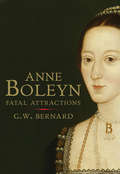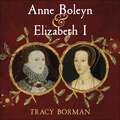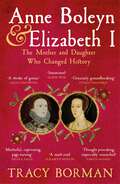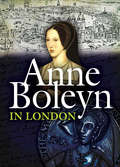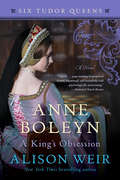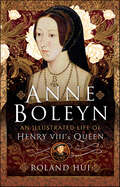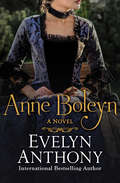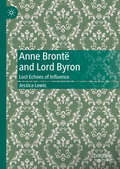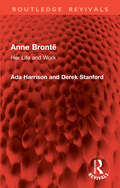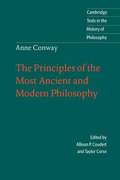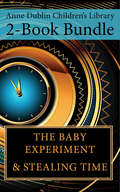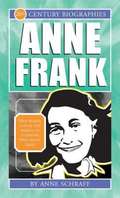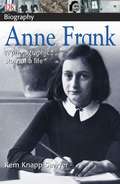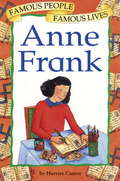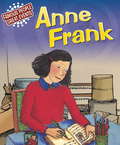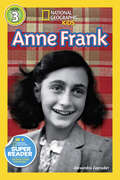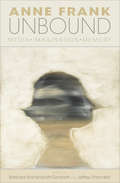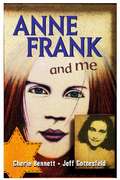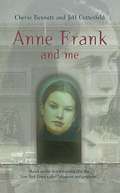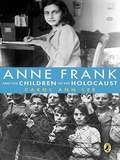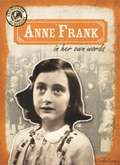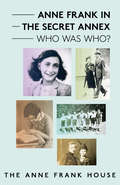- Table View
- List View
Anne Boleyn
by G. W. BernardIn this groundbreaking new biography, G. W. Bernard offers a fresh portrait of one of England's most captivating queens. Through a wide-ranging forensic examination of sixteenth-century sources, Bernard reconsiders Boleyn's girlhood, her experience at the French court, the nature of her relationship with Henry, and the authenticity of her evangelical sympathies. He depicts Anne Boleyn as a captivating, intelligent, and highly sexual woman whose attractions Henry resisted for years until marriage could ensure legitimacy for their offspring. He shows that it was Henry, not Anne, who developed the ideas that led to the break with Rome. And, most radically, he argues that the allegations of adultery that led to Anne's execution in the Tower could be close to the truth.
Anne Boleyn & Elizabeth I: The Mother and Daughter Who Changed History
by Tracy BormanOne of the most extraordinary mother and daughter stories of all time - Anne Boleyn, the most famous of Henry VIII's wives and her daughter Elizabeth, the 'Virgin Queen'.Anne Boleyn is a subject of enduring fascination. By far the most famous of Henry VIII's six wives, she has inspired books, documentaries and films, and is the subject of intense debate even today, almost 500 years after her violent death. For the most part, she is considered in the context of her relationship with Tudor England's much-married monarch. Dramatic though this story is, of even greater interest - and significance - is the relationship between Anne and her daughter, the future Elizabeth I.Elizabeth was less than three years old when her mother was executed. Given that she could have held precious few memories of Anne, it is often assumed that her mother exerted little influence over her.Nothing could be further from the truth. Elizabeth knew that she had to be discreet about Anne, but there is compelling evidence that her mother had a profound impact on her character, beliefs and reign. Anne's radical religious views shaped those of her daughter, and as a woman who wielded power over a male-dominated court, she provided an inspiring role model for Elizabeth's queenship. Even during Henry's lifetime, Elizabeth dared to express her sympathy for her late mother by secretly wearing Anne's famous 'A' pendant when she sat for a painting with her father and siblings.Piecing together evidence from original documents and artefacts, this book tells the fascinating, often surprising story of Anne Boleyn's relationship with, and influence over her daughter Elizabeth. In so doing, it sheds new light on two of the most famous women in history and how they changed England forever.(P) 2023 Hodder & Stoughton Limited
Anne Boleyn & Elizabeth I: The Mother and Daughter Who Changed History
by Tracy Borman'(A)sensational book by one of our greatest and best-loved historians... Astoundingly good.' - Alison Weir 'Masterful, captivating, page-turning, this is solid gold history at its best.' - Nicola Tallis'(A) thought-provoking, impeccably researched, and moving account uncovering how Anne's family, intellect, and tragedy shaped Elizabeth I's extraordinary career.' - Gareth Russell'Her extensive research... reveals them as the most dazzling female double act in history.' - Sarah Gristwood'Incredibly well-researched, elegantly written, and overall genuinely ground-breaking,' - Estelle ParanqueOne of the most extraordinary mother and daughter stories of all time - Anne Boleyn, the most famous of Henry VIII's wives and her daughter Elizabeth, the 'Virgin Queen'.Anne Boleyn is a subject of enduring fascination. By far the most famous of Henry VIII's six wives, she has inspired books, documentaries and films, and is the subject of intense debate even today, almost 500 years after her violent death. For the most part, she is considered in the context of her relationship with Tudor England's much-married monarch. Dramatic though this story is, of even greater interest - and significance - is the relationship between Anne and her daughter, the future Elizabeth I.Elizabeth was less than three years old when her mother was executed. Given that she could have held precious few memories of Anne, it is often assumed that her mother exerted little influence over her. But this is both inaccurate and misleading. Elizabeth knew that she had to be discreet about Anne, but there is compelling evidence that her mother exerted a profound influence on her character, beliefs and reign. Even during Henry's lifetime, Elizabeth dared to express her sympathy for her late mother by secretly wearing Anne's famous 'A' pendant when she sat for a painting with her father and siblings.Piecing together evidence from original documents and artefacts, this book tells the story of Anne Boleyn's relationship with, and influence over her daughter Elizabeth. In so doing, it sheds new light on two of the most famous and influential women in history.
Anne Boleyn in London
by Lissa ChapmanA portrait of the doomed queen&’s image and influence that provides &“a detailed look at real life in Tudor England&” (Manhattan Book Review). Romantic victim? Ruthless other woman? Innocent pawn? Religious reformer? Fool, flirt, and adulteress? Politician? Witch? During her life, Anne Boleyn, Henry VIII&’s ill-fated second queen, was internationally famous—or notorious. Today, she still attracts passionate adherents and furious detractors. It was in London that most of the drama of Anne Boleyn&’s life and death was played out, most famously in the Tower of London, the scene of her coronation celebrations, her trial, and her execution, and the place where her body lies buried. In her few years as a public figure, Anne Boleyn was influential as a patron of the arts and of French taste, as the center of a religious and intellectual circle, and for her purchasing power, both directly and as a leader of fashion. It was primarily to London, beyond the immediate circle of the court, that her carefully spun image as queen was directed during the public celebrations surrounding her coronation. In the centuries since Anne Boleyn&’s death, her reputation has expanded to give her an almost mythical status in London, inspiring everything from pub names to music hall songs and novels—not to mention merchandise including pincushions with removable heads. Over fifty Twitter accounts use some version of her name. This book looks at both the effect London and its people had on the course of Anne Boleyn&’s life and death—and the effects she had, and continues to have, on them.
Anne Boleyn, A King's Obsession: A Novel (Six Tudor Queens)
by Alison WeirIn this second novel of Alison Weir’s epic Six Tudor Queens series, the acclaimed author and historian weaves exciting new research into the story of Anne Boleyn, Henry VIII’s most infamous wife, a woman ahead of her time whose very life—and death—forever changed a nation. Born into a noble English family, Anne is barely a teenager when she is sent from her family’s Hever Castle to serve at the royal court of the Netherlands. Yet what seems a strategic move on the part of her opportunistic father is actually a chance for the girl to grow and discover herself. There, and later in France, Anne thrives, preferring to absorb the works of progressive writers rather than participate in courtly flirtations. She also begins to understand the inequalities and indignities suffered by her gender. Anne isn’t completely inured to the longings of the heart, but her powerful family has ambitious plans for her future that override any wishes of her own. When the King of England himself, Henry VIII, asks Anne to be his mistress, she spurns his advances—reminding him that he is a married man who has already conducted an affair with her sister, Mary. Anne’s rejection only intensifies Henry’s pursuit, but in the absence of a male heir—and given an aging Queen Katherine—the opportunity to elevate and protect the Boleyn family, and to exact vengeance on her envious detractors, is too tempting for Anne to resist, even as it proves to be her undoing. While history tells of how Anne Boleyn died, this compelling new novel shows just how she lived. Praise for Katherine of Aragon, the True Queen “Alison Weir starts off her six-volume fictional series about the wives of King Henry VIII with a nuanced portrayal of Katherine of Aragon.”—The Christian Science Monitor “In this first novel of the Six Tudor Queens series, Alison Weir dazzlingly brings Katherine of Aragon to life. She emerges as a charismatic, indomitable, and courageous heroine whose story never fails to enthrall.”—Tracy Borman, author of Thomas Cromwell “As always, Weir demonstrates a keen eye for crafting dramatic scenes of beautiful, accurate detail, instilling in the reader a vivid sense of being there. . . . If this greatly impressive inaugural installment is any indication, Tudor lovers have much to look forward to.”—Booklist (starred review) “An illuminating and engaging portrait of ‘the true queen.’”—Historical Novels Review
Anne Boleyn, An Illustrated Life of Henry VIII's Queen
by Roland HuiIf you remember my love in your prayers as strongly as I adore you, I shall hardly be forgotten, for I am yours,' - Henry Rex, forever Written by King Henry VIII to his sweetheart, the seductive and vivacious Anne Boleyn, his passion for her would be so great that Henry would make Anne his queen, and change the course of English history. But the woman whom Henry had promised to love for all time would go from palace to prison, charged with heinous crimes. Her life ended on a bloody scaffold in the Tower of London. Explore the incredible story of Anne Boleyn, the most famous and controversial of Henry VIII's six wives, in this exciting new account of her life told in words and pictures.
Anne Boleyn: A Novel (Grandes Novelas Ser.)
by Evelyn AnthonySet against the intrigue and pageantry of the sixteenth-century English court, Evelyn Anthony's novel tells the love story of Henry Tudor and Anne Boleyn, who would become his wife, his queen, and the mother of one of Britain's greatest monarchs On a lovely midsummer afternoon, Henry Tudor rides to Hever Castle. There, he feasts his eyes on Anne Boleyn, who caught his roving attention at court a few months earlier. Anne is in no mood to receive her king. He has torn from her the one man she loved: Harry Percy, who was forced to marry another. But King Henry VIII is not a man who gives up--the thrill of the chase only excites him more. Yet the woman he desires so passionately is no fool. Educated at the French court, Anne vows that she will not share the fate of her naïve younger sister, Mary, who after bearing Henry a bastard son was cast away and married off to a country squire. No, Anne will settle for nothing less than the crown of England, even if Henry has to break with Rome in order to marry her. History comes thrillingly alive in a novel that features a teeming canvas of iconic real-life characters: Cardinal Thomas Wolsey, the enemy Anne vows to destroy; Henry's first wife, the proud and pious Queen Catherine of Aragon; and Thomas Cromwell, who engineers Anne's downfall. From the halcyon early days of courtship to her imprisonment in the palace tower for treason, this is a tale of love, ambition, and the tragic destiny of Anne of the Thousand Days.
Anne Brontë and Lord Byron: Lost Echoes of Influence
by Jessica LewisThis book explores the relationship between Anne Brontë’s work and the life and writings of Lord Byron. Byron’s influence on the other Brontë siblings is well-documented but absent in Anne’s history. Building on recent discourses of rich intertextuality in Anne’s work, Jessica Lewis reveals her relationship with the poet as significantly different from that of her siblings. Instead of trying to emulate Byron or derive inspiration from the concept of ‘mix’d essences’ or elemental affinity, Anne’s relationship with him is grounded in their shared Calvinistic upbringing and a rejection of its stringent principles, which propels both writers to positions of contemporary religious controversy. This volume reappraises Anne Brontë and her work in light of significant Byronic influence, and provides new readings of her novels and poetry.
Anne Brontë: Her Life and Work (Routledge Revivals)
by Derek Stanford Ada HarrisonAlthough the Brontë story had been told many times, originally published in 1959, Ada Harrison and Derek Stanford wrote the first book to be devoted entirely to the life and work of Anne. The youngest of the three famous sisters, Anne was too often regarded as a mere appendage to the more spectacular Emily and Charlotte. Yet her work has stood the test of time no less than theirs. ‘If Anne Brontë had lived ten years longer,’ wrote George Moore, the first important critic to establish a claim for Anne as a writer of consequence, ‘she would have taken a place beside Jane Austen, perhaps even a higher place.’ It is in the light of such statements as this that the authors wrote their critical biography, showing the shy but engaging third sister as a writer and a character in her own right.The story of Anne’s life is told by Ada Harrison, who unfortunately did not live to see proofs of this book; the assessment of Anne’s verse and fiction is undertaken by the poet and critic, Derek Stanford. The issues they raise, and their general conclusions, may be regarded as controversial; but not only have they made a number of original points in this first book on Anne, they have also, by moving the spotlight, shed fresh illumination on the whole Brontë picture.
Anne Conway: The Principles of the Most Ancient and Modern Philosophy
by Karl Ameriks Desmond M. Clarke Anne Conway Allison P. Coudert Taylor CorseAnne Conway was an extraordinary figure in a remarkable age. Her mastery of the intricate doctrines of the Lurianic Kabbalah, her authorship of a treatise criticising the philosophy of Descartes, Hobbes, and Spinoza, and her scandalous conversion to the despised sect of Quakers indicate a strength of character and independence of mind wholly unexpected (and unwanted) in a woman at the time. Translated for the first time into modern English, her Principles of the Most Ancient and Modern Philosophy is the most interesting and original philosophical work written by a woman in the seventeenth century. Her radical and unorthodox ideas are important not only because they anticipated the more tolerant, ecumenical, and optimistic philosophy of the Enlightenment, but also because of their influence on Leibniz. This fully annotated edition includes an introduction which places Conway in her historical and philosophical contexts, together with a chronology of her life and a bibliography.
Anne Dublin Children's Library 2-Book Bundle: Stealing Time / The Baby Experiment
by Anne DublinFrom the imagination of Anne Dublin come two novels for young people, exploring incredible moments in history. Includes: The Baby Experiment In the early 18th century in Hamburg, Germany, Johanna gets a job as a caregiver at an orphanage. Until it's too late, she doesn't realize a secret experiment is taking place that results in the deaths of babies. Johanna decides to kidnap one of the orphanage's babies and escape with her to Amsterdam. Stealing Time Jonah Wiley is having a hard enough time adjusting to his parents' divorce, and when his mom goes to a conference — leaving him with his dad and stepmother — it only makes things worse. Now thanks to a strange pocket watch he and his stepbrother are trapped in time, racing to overcome tough challenges in order to get home.
Anne Frank
by Alison Kelly Susanna Davidson Eva SchlossLearn more about Anne Frank's life before she went into hiding with her family.
Anne Frank
by Anne SchraffAnne and her family moved to Amsterdam in 1933 after the Nazis gained power in Germany. She wrote a diary, which records her life from 12 June to 1 August 1944. Anne Frank died in early 1947
Anne Frank
by Kem Knapp SawyerTells the incredible story of this courageous young writer. In this groundbreaking new series, DK brings together fresh voices and DK design values to give readers the most information-packed, visually exciting biographies on the market today. Full-color photographs of people, places, and artifacts, definitions of key words, and sidebars on related subjects add dimension and relevance to stories of famous lives that students will love to read.
Anne Frank (Famous People, Famous Lives #7)
by Harriet CastorWhen Anne Frank is given a diary, she starts to write to her made-up friend, Kitty. But during World War II Anne and her family are forced to hide from the Nazi Germans. Find out all about the diary of Anne Frank with this story that is packed with all the facts and colourful pictures. This book is part of a series of books, Famous People, Famous Lives, which are suitable for ages 6-12. They tell the stories of famous men and women and great events in history. Written by successful authors, they are enjoyable reads which are packed with facts and illustrations.
Anne Frank (Famous People, Great Events #1)
by Harriet CastorWhen Anne Frank is given a diary, she starts to write to her made-up friend, Kitty. But during World War II Anne and her family are forced to hide from the Nazi Germans. Find out all about the diary of Anne Frank with this story that is packed with all the facts and colourful pictures. This book is part of a series of picture books, Famous People, Great Events, which are suitable for ages 6-12. They tell the stories of famous men and women and great events in history. Written by successful authors, they are enjoyable reads which are packed with facts and colourful illustrations.Each book includes a timeline of key dates, a quiz and index.
Anne Frank (Life And Times)
by Richard TamesTraces the life of a Jewish girl who chronicled her day-to-day life in a diary as she hid in an attic in Nazi-occupied Holland for two years.
Anne Frank (Readers Bios)
by Alexandra ZapruderAnne Frank is one of the first of many National Geographic Readers that highlight important historical figures. This level-3 reader brings an understanding of her historical significance to a whole new audience. Young readers will learn about the brave and tragic life of the young girl whose diary kept while in hiding from Nazis is one of the most important and insightful books of the World War II era. National Geographic Readers: Anne Frank explores not just the diary, but her life and the important role she played in 20th-century history.
Anne Frank Unbound: Media, Imagination, Memory (The Modern Jewish Experience)
by Barbara Kirshenblatt-Gimblett and Jeffrey Shandler&“A brilliantly conceived and long overdue opening up [or deconstruction] of the Anne Frank story.&” —James Clifford, Professor Emeritus, History of Consciousness Department, University of California As millions of people around the world who have read her diary attest, Anne Frank, the most familiar victim of the Holocaust, has a remarkable place in contemporary memory. Anne Frank Unbound looks beyond this young girl&’s words at the numerous ways people have engaged her life and writing. Apart from officially sanctioned works and organizations, there exists a prodigious amount of cultural production, which encompasses literature, art, music, film, television, blogs, pedagogy, scholarship, religious ritual, and comedy. Created by both artists and amateurs, these responses to Anne Frank range from veneration to irreverence. Although at times they challenge conventional perceptions of her significance, these works testify to the power of Anne Frank, the writer, and Anne Frank, the cultural phenomenon, as people worldwide forge their own connections with the diary and its author. &“This collection of brilliant essays offers fascinating and unexpected insights into the significance of Anne Frank&’s iconic Holocaust-era diary from many disciplinary perspectives in the arts and humanities.&” —Jan T. Gross, the Norman B. Tomlinson Professor of War and Society, Princeton University &“This volume is a major contribution to scholarship regarding Anne Frank's diary and its cultural influence . . . Highly recommended.&” —Choice &“Engrossing . . . The overall aim is to provide a greater understanding of the general and particular engagement with Anne Frank as a person, a symbol, an icon, an inspiration, and perhaps most polarizing, as one victim, not the victim of the Nazi holocaust.&” —Broadside
Anne Frank and Me
by Cherie Bennett Jeff GottesfeldKnocked unconscious after explosions ring out during a field trip to an Anne Frank exhibit, boy-crazy Nicole Burns wakes to find herself living a parallel life as a Jew in 1942 Paris. This Nicole is dating the boy of her present-day dreams, but living under the Nazis gradually becomes a nightmare. Her family survives the Nazi occupation with the help of friends, but when her father is exposed as a resistant, their fate takes a dire turn. The shifts in Nicole's lives--from a carefree, sophisticated Parisian girl to a wretch riding in a cattle car with Anne Frank; from a modern girl focused only on the drama of her high school life to a thoughtful observer of the potential of everyday injustices--will engage teens and change their views of history found in books and the history we're making today.
Anne Frank and Me
by Cherie BennettThe successful play is now a gripping novel. Knocked unconscious after explosions ring out during a field trip to an Anne Frank exhibit, boy-crazy Nicole Burns wakes to find herself living a parallel life as a Jew in 1942 Paris. This Nicole is dating the boy of her present-day dreams, but living under the Nazis gradually becomes a nightmare. Her family survives the Nazi occupation with the help of friends, but when her father is exposed as a resistant, their fate takes a dire turn. The shifts in Nicole's lives--from a carefree, sophisticated Parisian girl to a wretch riding in a cattle car with Anne Frank; from a modern girl focused only on the drama of her high school life to a thoughtful observer of the potential of everyday injustices--will engage teens and change their views of history found in books and the history we're making today. Called "eloquent and poignant" by the New York Times and performed to wide acclaim across the country, the play has touched thousands. As a novel, it is sure to grow in popularity.
Anne Frank and Me
by Cherie Bennett Jeff GottesfeldIn one moment Nicole Burns's life changes forever. The sound of gunfire at an Anne Frank exhibit, the panic, the crowd, and Nicole is no longer Nicole. Whiplashed through time and space, she wakes to find herself a privileged Jewish girl living in Nazi-occupied Paris during World War II. No more Internet diaries and boy troubles for Nicole-now she's a carefree Jewish girl, with wonderful friends and a charming boyfriend. But when the Nazi death grip tightens over France, Nicole is forced into hiding, and begins a struggle for survival that brings her face to face with Anne Frank. "This is a powerful and affecting story." (KLIATT)
Anne Frank and the Children of the Holocaust
by Carol Anne LeeAnne Frank's diary changed how the world saw the Holocaust? this book will change how you see Anne Frank. Beginning with Otto Frank's idyllic childhood, follow the family's journey from its proud German roots through life under Nazi occupation to their horrifying concentration camp experiences. Interspersed with their story are personal accounts of survivors, excerpts from the other victims? journals, and black-and-white photos. A perfect blend of historical information and emotional narratives, this book makes an excellent companion to the diary, offering an in-depth look at the life of Anne Frank, and an intimate history of the young people who experienced the Holocaust. .
Anne Frank in Her Own Words
by Caroline KennonAnne Frank's youthful optimism was a stark contrast to the terrible monstrosities of World War II. While Anne and her family hid from the world in a secret annex, she confided in her diary, nicknamed Kitty, providing the world with an inside view of what it was like to grow up fearing the wrath of Nazi Germany. This biography uses Anne's moving writings to highlight the events of her short life. Her diary is a powerful tool and reminder of the unjust hate that caused the Holocaust. Sidebars and fact boxes offer more information about this time period.
Anne Frank in the Secret Annex: Who Was Who?
by The Anne Frank HouseAn extraordinary story of Anne Frank and the Secret Annex For two years during the Second World War, young, Jewish Anne Frank lived in hiding from the Nazis. Everything she experienced, thought, and felt, she confided in her diary. She was just as frank in her descriptions of the seven other people in the Annex and of the five helpers who endangered their own lives to look after them. Years later, Anne Frank's diary became world famous. The Secret Annex was so well set up that the hiders survived there for over two years. Who were these people, how did they meet, and what happened to them? This book shows the background and organization of the Annex and the personal stories of all involved, as well as their relationships and their fates. It also offers many never-before-published photographs. The result is an extraordinary group portrait that stays with the reader long after the last page is turned.
